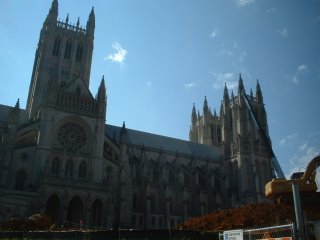
I was thrilled yesterday to be able to stop at the Washington National Cathedral. Still under some constructions it's a beautiful site. The stain glass is amazing!
The idea for a national cathedral is as old as Washington itself. In 1791, when Congress selected the site to be the capital of the United States, President George Washington commissioned Major Pierre l’Enfant to design an overall plan for the future seat of government.
Included in l’Enfant’s plan was a church, “intended for national purposes, such as public prayer, thanksgiving, funeral orations, etc., and assigned to the special use of no particular Sect or denomination, but equally open to all.”
Largely through the efforts of Washington community leaders such as Riggs Bank President Charles C. Glover, plans for building Washington National Cathedral gained momentum. On January 6, 1893, Congress granted a charter to the Protestant Episcopal Cathedral Foundation of the District of Columbia, allowing it to establish a cathedral and institutions of higher learning. Signed by President Benjamin Harrison, this charter was the birth certificate of Washington National Cathedral.
After his consecration in 1896, the Rev. Dr. Henry Yates Satterlee, the first bishop of Washington, managed to secure land on Mount Saint Alban — the most commanding spot in the entire Washington area.
On September 29, 1907, the foundation stone was laid. President Theodore Roosevelt and the Bishop of London spoke to the crowd of ten thousand. The stone itself came from a field near Bethlehem and was inset into a larger piece of American granite. On it was the inscription: “The Word was made flesh, and dwelt among us” (John 1:14). With the laying of the cathedral foundation stone, the grassy, tree — shaded Close became home to the longest — running construction site in the nation’s capital.
In 1912, Bethlehem Chapel opened for services which have continued daily ever since. In October 1928, President Calvin Coolidge came to open the General Convention of the Episcopal Church at the Cathedral.
The Cathedral quickly became a place for services of national focus. When the United States entered World War II in 1941, monthly services “On behalf of a united people in a time of emergency” began. Holy Spirit Chapel served as a War Shrine and community memorial services were held.
As construction continued, Washington National Cathedral continued to take its place in history. President Woodrow Wilson’s tomb was dedicated in 1956 (Wilson is the only US president buried within the boundaries of the District of Columbia.) The Rev. Dr. Martin Luther King, Jr., preached his last Sunday sermon from the Canterbury Pulpit in 1968. Thousands gathered for President Dwight D. Eisenhower’s funeral in 1969.
In 1976, the Cathedral’s nave and west rose window were completed and dedicated in the presence of Queen Elizabeth II and president Gerald Ford. It was also the place the nation gave thanks when the American hostages in Iran were freed.
The Pilgrim Observation Gallery was completed and opened to the public in 1982. In 1983 the final phase of construction began with the setting of the first stone for the west towers.
The completion of the west towers in September 1990 marked the end of eighty-three years of construction.
The Cathedral continues to be a place of national focus. It was the site of President George W. Bush’s Inaugural Prayer Service and later the National Prayer and Remembrance service on September 14, 2001. On December 25, 2002, the Cathedral broadcast its fiftieth national Christmas service.
Since the first services were held in Bethlehem Chapel, Washington National Cathedral has opened its doors to people of all faiths as they have gathered to worship and pray, to mourn the passing of world leaders, and to confront the pressing moral and social issues of the day.
For more visit: http://www.cathedral.org
No comments:
Post a Comment